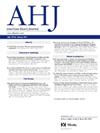Impact of a clinical atrial fibrillation risk estimation tool on cardiac rhythm monitor utilization following acute ischemic stroke: A prepost clinical trial
IF 3.7
2区 医学
Q1 CARDIAC & CARDIOVASCULAR SYSTEMS
引用次数: 0
Abstract
Background
Detection of undiagnosed atrial fibrillation (AF) after ischemic stroke through extended cardiac monitoring is important for preventing recurrent stroke. We evaluated whether a tool that displays clinically predicted AF risk to clinicians caring for stroke patients was associated with the use of extended cardiac monitoring.
Methods
We prospectively included hospitalized ischemic stroke patients without known AF in a preintervention (October 2018 - June 2019) and intervention period (March 11, 2021 - March 10, 2022). The intervention consisted of an electronic health record (EHR)-based best-practice advisory (BPA) alert which calculated and displayed 5-year risk of AF. We used a multivariable Fine and Gray model to test for an interaction between predicted AF risk and period (preintervention vs intervention) with regards to incidence of extended cardiac monitoring. We compared the incidence of extended cardiac monitoring within 6-months of discharge between periods, stratified by BPA completion.
Results
We included 805 patients: 493 in the preintervention cohort and 312 in the intervention cohort. In the intervention cohort, the BPA was completed for 180 (58%) patients. The association between predicted clinical risk of AF and incidence of 6-month extended cardiac monitoring was not different by time period (interaction HR = 1.00 [95% Confidence Interval (CI) 0.98; 1.02]). The intervention period was associated with an increased cumulative incidence of cardiac monitoring (adjusted HR = 1.32 [95% CI 1.03-1.69]).
Conclusions
An embedded EHR tool displaying predicted AF risk in a poststroke setting had limited clinician engagement and predicted risk was not associated with the use of extended cardiac monitoring.
Clinical Trial Registration
NCT04637087
急性缺血性卒中后心房颤动风险评估工具对心律监测仪使用的影响:一项临床前-后试验
背景:通过扩展心脏监测发现缺血性卒中后未确诊的心房颤动(AF)对预防卒中复发具有重要意义。我们评估了一种显示临床预测心房颤动风险的工具是否与延长心脏监测的使用有关。方法:在干预前(2018年10月- 2019年6月)和干预期(2021年3月11日- 2022年3月10日)前瞻性纳入未发现房颤的住院缺血性脑卒中患者。干预包括基于电子健康记录(EHR)的最佳实践咨询(BPA)警报,该警报计算并显示5年房颤风险。我们使用多变量Fine和Gray模型来测试预测房颤风险与延长心脏监测发生率(干预前与干预)之间的相互作用。我们比较了出院后6个月内延长心脏监测的发生率,并按BPA完成程度分层。结果:我们纳入805例患者:干预前队列493例,干预队列312例。在干预队列中,180例(58%)患者完成了BPA。预测房颤临床风险与6个月延长心脏监测发生率之间的相关性在不同时间段没有差异(相互作用HR = 1.00[95%可信区间(CI) 0.98;1.02])。干预期与心脏监测累积发生率增加相关(调整后HR = 1.32 [95% CI 1.03-1.69])。结论:嵌入式EHR工具显示中风后预测的房颤风险限制了临床医生的参与,预测的风险与扩展心脏监测的使用无关。临床试验注册:NCT04637087。
本文章由计算机程序翻译,如有差异,请以英文原文为准。
求助全文
约1分钟内获得全文
求助全文
来源期刊

American heart journal
医学-心血管系统
CiteScore
8.20
自引率
2.10%
发文量
214
审稿时长
38 days
期刊介绍:
The American Heart Journal will consider for publication suitable articles on topics pertaining to the broad discipline of cardiovascular disease. Our goal is to provide the reader primary investigation, scholarly review, and opinion concerning the practice of cardiovascular medicine. We especially encourage submission of 3 types of reports that are not frequently seen in cardiovascular journals: negative clinical studies, reports on study designs, and studies involving the organization of medical care. The Journal does not accept individual case reports or original articles involving bench laboratory or animal research.
 求助内容:
求助内容: 应助结果提醒方式:
应助结果提醒方式:


